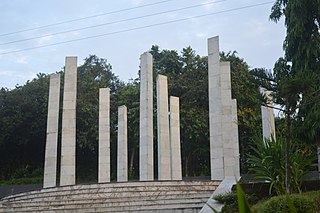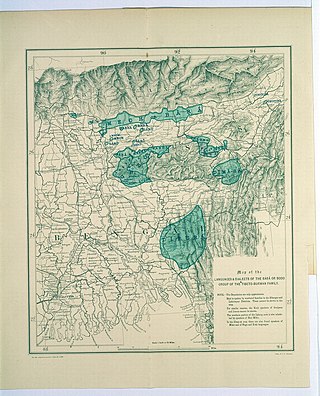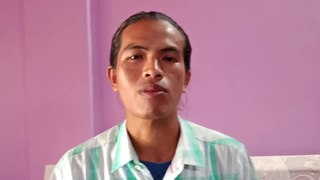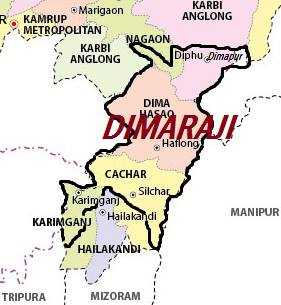
Assam is a state in northeastern India, south of the eastern Himalayas along the Brahmaputra and Barak River valleys. Assam covers an area of 78,438 km2 (30,285 sq mi). It is the second largest state in northeastern India by area and the largest in terms of population. The state is bordered by Bhutan and Arunachal Pradesh to the north; Nagaland and Manipur to the east; Meghalaya, Tripura, Mizoram and Bangladesh to the south; and West Bengal to the west via the Siliguri Corridor, a 22-kilometre-wide (14 mi) strip of land that connects the state to the rest of India. Assamese and Boro are the official languages of Assam. Meitei (Manipuri) is the official language of Hojai district and the entirety of the Barak Valley region, while Bengali is an official language in the three districts of Barak Valley.

Cachardistrict is an administrative district in the state of Assam in India. After independence, the pre-existing undivided Cachar district was split into four districts: Dima Hasao, Hailakandi, Karimganj, and the current Cachar district. Silchar is Cachar district's center of government.

Dima Hasao district, is an administrative district in the state of Assam, India. As of 2011, it is the least populous district of Assam.

Boro, also rendered Bodo, is a Sino-Tibetan language spoken primarily by the Boros of Northeast India and the neighboring nations of Nepal and Bangladesh. It is an official language of the Indian state of Assam, predominantly spoken in the Bodoland Territorial Region. It is also one of the twenty-two languages listed in the Eighth Schedule of the Constitution of India. Since 1975 the language has been written using the Devanagari script. It was formerly written using Latin and Eastern-Nagari scripts. Some scholars have suggested that the language used to have its own now lost script known as Deodhai.

The Dimasa Kingdom was a late medieval/early modern kingdom in Assam, Northeast India ruled by Dimasa kings. The Dimasa kingdom and others that developed in the wake of the Kamarupa kingdom were examples of new states that emerged from indigenous communities in medieval Assam as a result of socio-political transformations in these communities. The British finally annexed the kingdom: the plains in 1832 and the hills in 1834. This kingdom gave its name to undivided Cachar district of colonial Assam. And after independence the undivided Cachar district was split into three districts in Assam: Dima Hasao district, Cachar district, Hailakandi district. The Ahom Buranjis called this kingdom Timisa.

The Dimasa people are an ethnolinguistic community presently inhabiting in Assam and Nagaland states in Northeastern India. They speak Dimasa, a Tibeto-Burman language. This community is fairly homogeneous and exclusive, with members required to draw from both parents' separate clans. Dimasa kingdom, one of many early states in Assam following the downfall of Kamarupa kingdom, was established by these people. The Dimasas were till recently agricultural, centering on shifting agriculture; but in recent times this has changed with profound changes in the community. Following political problems in the 18th century, the Dimasa ruler moved further south in the plains of Cachar and there took place a division among them–with the hills Dimasa maintaining their traditional living and political exclusiveness, the plains Dimasas have made no attempt to assert themselves.
Dimasa may refer to the following entities in Northeast India :

Kachari is a Sino-Tibetan language of the Boro-Garo branch that is spoken in Assam, India. With fewer than 60,000 speakers recorded in 1997, and the Asam 2001 Census reporting a literacy rate of 81% the Kachari language is currently ranked as threatened. Kachari is closely related to surrounding languages, including Tiwa, Rābhā, Hajong, Kochi and Mechi.

The Barak Valley is the southernmost region and administrative division of the Indian state of Assam. It is named after the Barak river. The Barak valley consists of three administrative districts of Assam namely - Cachar, Karimganj, and Hailakandi. The main and largest city is Silchar, which seats the headquarter of Cachar district and also serves as administrative divisional office of Barak valley division. The valley is bordered by Mizoram and Tripura to the south, Bangladesh and Meghalaya to the west and Manipur to the east respectively. Once North Cachar Hills was a part of Cachar district which became a subdivision in 1951 and eventually a separate district. On 1 July 1983, Karimganj district was curved out from the eponymous subdivision of Cachar district. In 1989 the subdivision of Hailakandi was upgraded into Hailakandi district.
Dima Halam Daogah was an Indian extremist group operating mainly in Assam and Nagaland. The group laid down their arms in January 2013, and claimed to represent the Dimasa and their goal to create a Dimaland or Dimaraji in the two states.

The Karbi language is spoken by the Karbi people of Northeastern India.
Moran (Morān) is an extinct Boro-Garo language which was spoken in Assam in Northeast India and related to Dimasa language. The census returned 78 speakers in 1901, 24 in 1911 and none in 1931, and the only source of this language exists in a 1904 article by P R Gurdon. The speakers of this language have shifted to the Assamese language. The name "Moran" reportedly means 'forest dweller'.
The Regions of Assam are non-administrative units in the Indian state of Assam with a common historical past. Not all these regions are mutually exclusive.

Some Dimasa-Cachar people of northeast India have been demanding a separate state called Dimaraji or "Dimaland" for several decades. It would comprise the Dimasa-inhabited areas, namely Dima Hasao district, parts of Cachar district, parts of Nagaon district, Hojai district and Karbi Anglong district in Assam together with part of Dimapur district in Nagaland.
The Barman Kacharis are an indigenous community of Northeast India and are a subsection of the Dimasa people in Barak Valley but claim to a separate group in Brahmaputra Valley. They are mainly found in the districts of Lower Assam and in Barak Valley like Cachar, Hailakandi and Karimganj and some parts of Arunachal Pradesh. Barman Kachari is Dimasa convert group of North-East India. Since the 2002 Amendment act, many Barman Kacharis in Assam are referred to as 'Barman'. They are sparsely found in Brahmaputra valley.

The West Karbi Anglong district is a district of the Indian state of Assam. It is a relatively new district formed out of the existing Karbi Anglong district in 2016. The administrative headquarters of the district is located at Hamren. The district is a part of the Karbi Anglong Autonomous Council and is administered according to the provisions of the Sixth Schedule of the Indian Constitution.

Hojai District is a district in Assam, India. It was formed on 15 August 2015. The headquarters of the district is situated at Sankardev Nagar, which is about 8 km away from Hojai town. Hojai District was formed from three tehsils of Nagaon District, namely Hojai, Doboka and Lanka. Hojai was a part of undivided Nowgong district of then Assam Province.
Barman Thar, where “thar” means language, is a highly endangered language. It is a Tibeto-Burman language that belongs to the Boro–Garo sub-group. The population of the Barman Kachari community is 24,237, according to a 2017 census. However, only a small part of this population speaks the language.

The Dimasa Kachari plains tribe of Cachar are known as Barman, forming one of the indigenous tribes of undivided Cachar. The Dimasas, inhabiting in the Cachar district are officially recognized as one of the Scheduled Tribes under the plains category in Assam in the name called “Barmans in Cachar”.
Dimasa is section of KACHARI community. It belongs to Boro-Garo language family. It is mother tongue to around 500,000 Dimasa population. Large section of Sanskritised Dimasa speak Assamese language e.g. Sonowal Kachari, Thengal Kachari, Moran Kachari, Matak Kachari.











